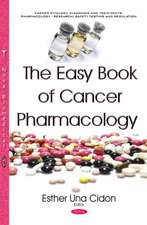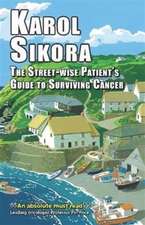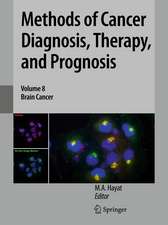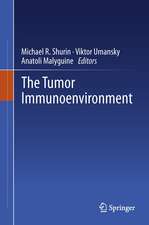Experimental Metastasis: Modeling and Analysis
Editat de Anastasia Maleken Limba Engleză Hardback – 17 dec 2013
| Toate formatele și edițiile | Preț | Express |
|---|---|---|
| Paperback (1) | 1090.04 lei 6-8 săpt. | |
| SPRINGER NETHERLANDS – 17 sep 2016 | 1090.04 lei 6-8 săpt. | |
| Hardback (1) | 1100.30 lei 6-8 săpt. | |
| SPRINGER NETHERLANDS – 17 dec 2013 | 1100.30 lei 6-8 săpt. |
Preț: 1100.30 lei
Preț vechi: 1158.20 lei
-5% Nou
Puncte Express: 1650
Preț estimativ în valută:
210.55€ • 225.14$ • 175.55£
210.55€ • 225.14$ • 175.55£
Carte tipărită la comandă
Livrare economică 18 aprilie-02 mai
Preluare comenzi: 021 569.72.76
Specificații
ISBN-13: 9789400778344
ISBN-10: 9400778341
Pagini: 210
Ilustrații: VIII, 210 p. 71 illus., 32 illus. in color.
Dimensiuni: 155 x 235 x 15 mm
Greutate: 0.57 kg
Ediția:2013
Editura: SPRINGER NETHERLANDS
Colecția Springer
Locul publicării:Dordrecht, Netherlands
ISBN-10: 9400778341
Pagini: 210
Ilustrații: VIII, 210 p. 71 illus., 32 illus. in color.
Dimensiuni: 155 x 235 x 15 mm
Greutate: 0.57 kg
Ediția:2013
Editura: SPRINGER NETHERLANDS
Colecția Springer
Locul publicării:Dordrecht, Netherlands
Public țintă
Professional/practitionerCuprins
Preface.- Introduction.- Head and neck cancer.- Breast cancer invasion and metastasis.- Mouse models of pancreatic cancer.- Brain Metastasis.- Lung metastasis.- Liver Metastases.- Malignant pleural effusion.- Mathematic modeling of metastatic process. Index.
Textul de pe ultima copertă
Metastatic dissemination remains a main cause for cancer related deaths. Investigation of the molecular mechanisms of the metastatic process presents an important area of cancer research and may provide clinical oncologists with new methods to prevent and manage cancer dissemination.
Availability of adequate experimental models is an essential requirement of the productive investigation. Over the many years of cancer research, plenty of model systems (in vitro and in vivo) were created to reproduce certain steps or to estimate certain aspects of metastatic process. Currently right selection and correct application of the experimental models as well as analytic technique may present a challenge.
This book provide with guideline information about experimental modelling and analysis of the metastatic process. The structure of the book reflects clinical aspects: pathway and area of the metastatic dissemination. Thus, first part of book is devoted to local, mainly via lymph system, spread of head and neck, breast and pancreatic cancers. Second part is about distant, via blood stream, dissemination into brain and lung (most often sites of metastatic lesion regardless the primary tumour issue). Third part includes chapter describing methods of modelling and study specific metastatic pathways: via portal vein system and through serous cavities. Any chapter is introduced by short review of clinical/biological aspects of the specific metastatic process, provides with description of relevant laboratory techniques, supplemented with representative illustrations and extended references list. Theoretic aspects of cancer dissemination and mathematic approaches to model metastatic spread of tumour are reviewed in the last chapter.
Chapters ofthe book are written by leading specialists in certain areas of metastatic cancer research, therefore the book presents a comprehensive guide for researchers and may be helpful for clinical oncologists.
Availability of adequate experimental models is an essential requirement of the productive investigation. Over the many years of cancer research, plenty of model systems (in vitro and in vivo) were created to reproduce certain steps or to estimate certain aspects of metastatic process. Currently right selection and correct application of the experimental models as well as analytic technique may present a challenge.
This book provide with guideline information about experimental modelling and analysis of the metastatic process. The structure of the book reflects clinical aspects: pathway and area of the metastatic dissemination. Thus, first part of book is devoted to local, mainly via lymph system, spread of head and neck, breast and pancreatic cancers. Second part is about distant, via blood stream, dissemination into brain and lung (most often sites of metastatic lesion regardless the primary tumour issue). Third part includes chapter describing methods of modelling and study specific metastatic pathways: via portal vein system and through serous cavities. Any chapter is introduced by short review of clinical/biological aspects of the specific metastatic process, provides with description of relevant laboratory techniques, supplemented with representative illustrations and extended references list. Theoretic aspects of cancer dissemination and mathematic approaches to model metastatic spread of tumour are reviewed in the last chapter.
Chapters ofthe book are written by leading specialists in certain areas of metastatic cancer research, therefore the book presents a comprehensive guide for researchers and may be helpful for clinical oncologists.
Caracteristici
Structure of the book is based on anatomical areas of cancer dissemination that has clinical relevance Any chapter is written/supervised by leading researcher in specific area of metastasis research The book is focused on experimental approach of metastatic cancer research: any chapter contains supportive theoretical information and detailed description of relevant laboratory procedures The book is supplemented by informative illustrations, schemes and tables Extensive lists of references for any chapter provides with possibility of effective deep study Includes supplementary material: sn.pub/extras



























